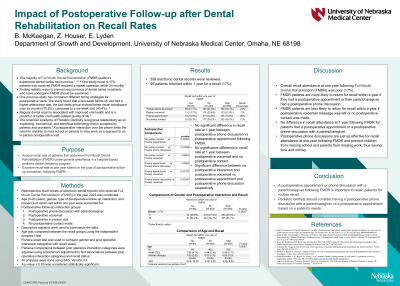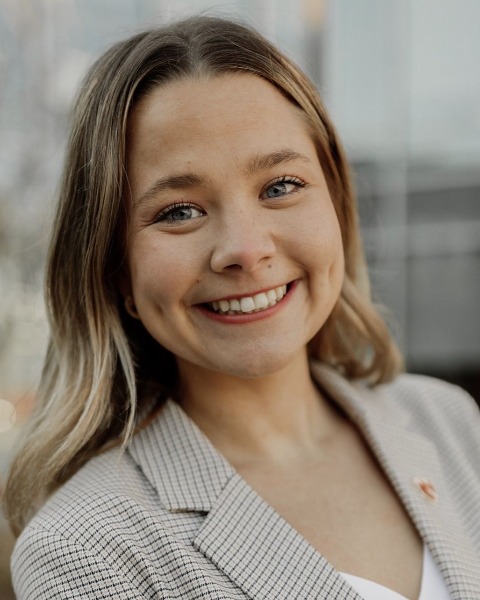Preventive
297 - Impact of Postoperative Follow-Up after Dental Rehabilitation on Recall Rates


Bridget C. McKeegan, DDS (she/her/hers)
Resident
University of Nebraska Medical Center
University Of Nebraska Medical Center
Omaha, Nebraska, United States- ZH
Zachary L. Houser, DMD
Program Director
University of Nebraska Medical Center
Omaha, Nebraska, United States - EL
Elizabeth Ruby Lyden, MS
University of Nebraska Medical Center
- ZH
Zachary L. Houser, DMD
Program Director
University of Nebraska Medical Center
Omaha, Nebraska, United States
Presenting Author(s)
Co-Author(s)
Program Director(s)
Purpose: Evaluate the recall rate of patients that underwent Full Mouth Dental Rehabilitation under general anesthesia (FMDR) in a hospital-based residency program and to examine if different postoperative follow-up interactions impact recall attendance rates.
Methods: Retrospective chart review of electronic dental records for patients who received FMDR in the year 2023 will be conducted. Age, gender, type of postoperative follow-up method (in-person visit, phone discussion with parent/caregiver, voicemail, no contact), and recall attendance within one year will be accounted for. Inferential statistics will be used to calculate the recall rate with a 95% confidence interval of FMDR patients. Subgroups based on age, gender, and postoperative interaction type will be analyzed using parametric analysis to look for statistical significance between variables and their impact on recall attendance.
Results: Recall rate was (17%). Postoperative interaction was significantly associated with recall rates (p = 0.001); patients with a postoperative appointment (28%) or phone discussion (23%) had higher recall rates than those with no contact (12%) or voicemail (11%). Pairwise comparisons showed significant differences between no contact and postoperative appointment (p = 0.021), and no contact and phone discussions (p = 0.036). No significant difference between postoperaptive appointment and phone discussion. A significant association was found between gender and recall visits (p = 0.042), with males more likely to return. Additionally, patients who returned for recall were significantly older (mean age 7.89 years) than those who did not (mean age 6.44 years, p = 0.0053).
Conclusion: The study found that postoperative interaction of an in-person visit or phone interaction plays a critical role in recall visits within one year of FMDR. Patients who had a postoperative appointment or a phone discussion were significantly more likely to return for recall than those who had no postoperative interaction or only received a voicemail. Older children were more likely to return for recall visits than younger patients. These findings suggest that direct postoperative engagement, particularly through follow-up appointments and phone discussions, can improve patient adherence to recall visits. The use of phone discussion as a postoperative interaction should be considered to avoid the need for families to miss work or school and can be just as effective as an in-person visit.
Identify Supporting Agency and Grant Number:
Research supported by the Department of Growth and Development at the University of Nebraska Medical Center College of Dentistry.

.jpg)